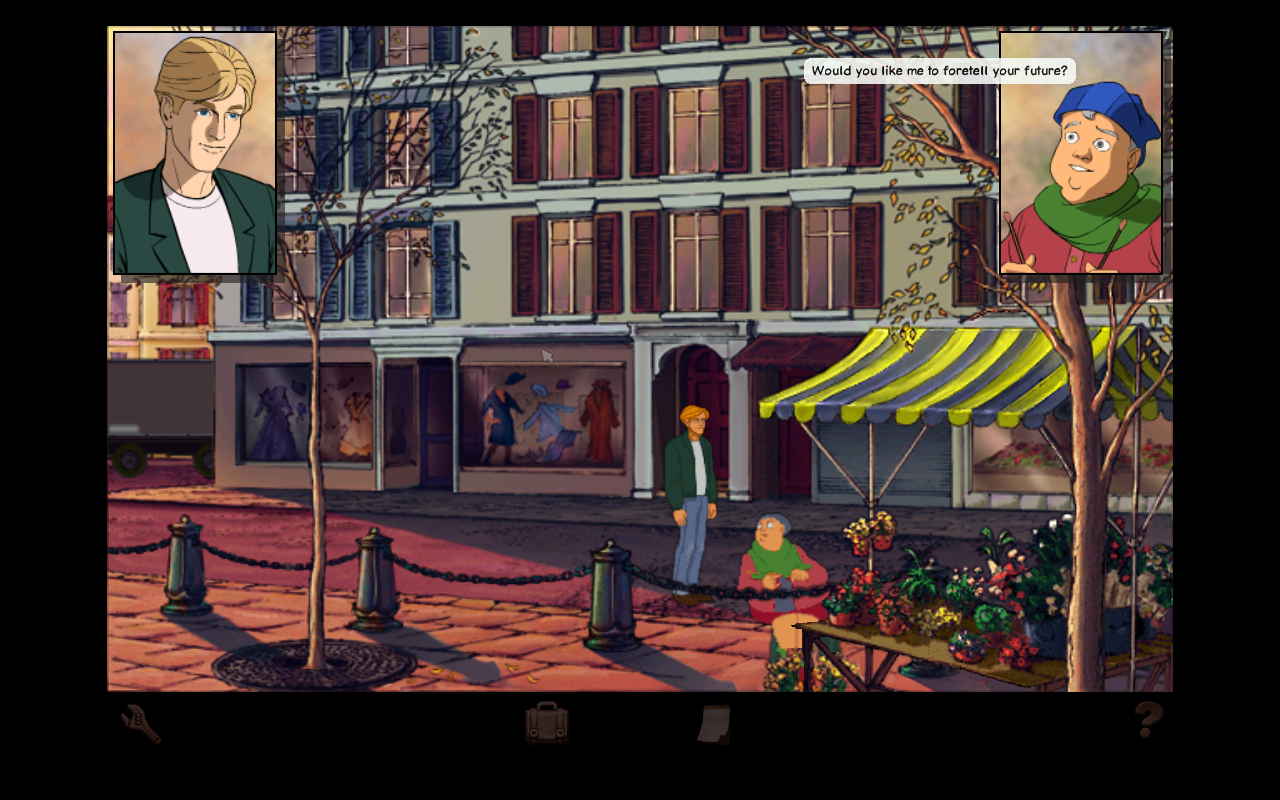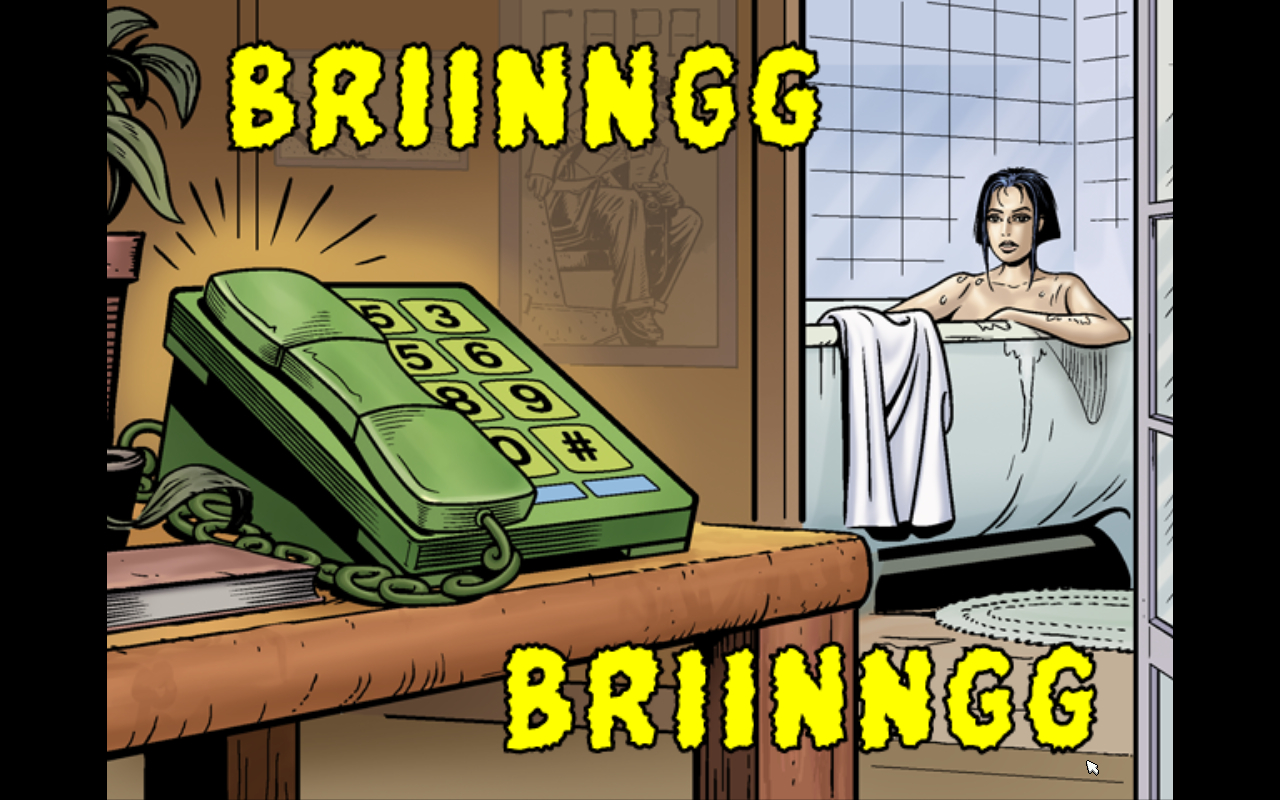Search
[{{{type}}}] {{{reason}}}
{{/data.error.root_cause}}{{{_source.title}}} {{#_source.showPrice}} {{{_source.displayPrice}}} {{/_source.showPrice}}
{{#_source.showLink}} {{/_source.showLink}} {{#_source.showDate}}{{{_source.displayDate}}}
{{/_source.showDate}}{{{_source.description}}}
{{#_source.additionalInfo}}{{#_source.additionalFields}} {{#title}} {{{label}}}: {{{title}}} {{/title}} {{/_source.additionalFields}}
{{/_source.additionalInfo}}- Details
- Category: Computer
- By J. Todd Cumming
- Hits: 6389
Broken Sword - Shadow of the Templars (Mac)

Broken Sword - Shadow of the Templars
Developed by: Revolution Software
Published by: Revolution Software
Released: March 24, 2009 (Wii), September 2, 2010 (Windows, OS X), June 18, 2013 (Linux)
Available on: Wii, Nintendo DS, iOS, Windows, Mac (reviewed), Android, Linux
Genre: Adventure
ESRB rating: T
Number of players: 1
Price: $4.99 (Steam), $5.00 on Leap Trade (Wii edition)
The Knights Templar was a religious order that existed in the twelfth and thirteenth century and into the early fourteenth, to be disbanded by Pope Clementine V in 1312. The organization not only included some of the most powerful military units of the Crusades, they also established the first banking institutions in the world. With their power, though, came rumors about their practices, and their disbanding and disappearance has led to hundred of legends about them since that time. The first Broken Sword game, called “Shadow of the Templars” is an adventure game that also focused on the history and rumors of the Knights Templar to create an entertaining narrative.
The game initially came out in 1996, and was known as “Circle of Blood” in the United States. The game was praised for its storyline and innovative approach to the adventure game genre. In 2008, the game was remade as a “Director's Cut,” and released for the Wii and Nintendo DS, with updated graphics and an expanded storyline. The game eventually spread to other gaming platforms, including iOS and Android.
The game plays out much like most computer adventure games. The player takes the role of the French reporter Nico Collard or American tourist George Stobbard. At first the adventure hinges upon trying to learn the identity and motives of the “costume killer,” an assassin that puts on different costumes before slaying specific targets. As their investigation deepens, though, they uncover evidence of a greater conspiracy at work, and the machinations of a sinister organization trying to take over the world.

Strong Points: Great storyline, good music
Weak Points: Inconsistent graphic styles
Moral Warnings: Language issues, violence, some blood
As with most adventure games, the player needs to click to indicate where their character is to walk. They can click on different portions of the screen – highlighted by throbbing blue circles – in order to interact with objects on the screen, to pick items up, or to speak with other people. The user interface is graphic-based. For example, if you want to talk to someone about a rubber clown's nose, you simply click on the clown's nose in your inventory to bring it into the conversation. If you want to try to use the items in your inventory with something on the screen, you drag it out of your satchel and onto the object in question. Most of the time, these interactions won't work, but every once in a while you'll discover something that helps to move the narrative forward. With the blue circles to indicate what you can interact with, it helps greatly to avoid the “pixel clicker” aspect that many adventure games unfortunately fall into.
There are a few amusing puzzles at the beginning of the game, including some sliding block locks and clever cryptograms, and again toward the end. However, the bulk of the game is played from the perspective of George Stobbard and is typical for adventure games – wander around, talk to people, try to use objects in different ways, and figure out more clues. After such a strong start, it was disappointing to see the game fall into such mundane techniques.
The voice acting is decent, but on occasion it's blatantly obvious that some of the lines in the conversation were recorded at different locations. This is especially disappointing when it happens when the scene doesn't change. The dialogue is written out so it's easy to read what everyone is saying, but there is no way to turn the closed captioning on for the cutscenes that take place periodically.

Higher is better
(10/10 is perfect)
Game Score - 72%
Gameplay - 14/20
Graphics - 4/10
Sound - 8/10
Stability - 5/5
Controls - 5/5
Morality Score - 70%
Violence - 4/10
Language - 4/10
Sexual Content - 10/10
Occult/Supernatural - 7/10
Cultural/Moral/Ethical - 10/10
There aren't very many cutscenes, but those that exist do stand out – not because they're good, but because of how truly bad they are. Although I'm not normally one to criticize a game because of its poor graphics, those in the first Broken Sword are so dichotomous as to be jarring. The cutscenes look like low-budget Don Bluth knock-offs – these may be the ones that appeared in the game originally back in 1996, but it would have been nice to see these updated. The main gameplay has the slightly pixellated style that can be expected from a game in the 1990s, but engaging in dialogue will bring up animated portraits of the participants that are much sharper in appearance. It's nice to see the expressions on the faces as different topics are discussed. In addition to those, there also is a hidden series of comic-like panels that detail some of the history of Nico Collard and her deceased father. These are reminiscent of a style of DC Comics. The opening and closing movies also use this style, unlike the other cutscenes that appear in the game. Although the artwork does convey the story and action well enough, the different styles almost seem to clash with each other, and if it wasn't for the similar hairstyles and clothing, it would be easy to confuse the characters from one art form to the next.
The strongest aspect of the game, though, is the story. It's engaging and can keep the player interested in what's happening. Occasionally the narrative is interrupted by trying to figure out what to do next (hint – if you're stuck, try talking to people that you've already spoken with), but for the most part, the challenges aren't too difficult to solve. The game can be finished in 12-14 hours, which is a decent length for an adventure game.
The game can be violent at times – at least two characters die on-screen, and one of the animated cutscenes shows a person hit with a car. However, there is very little blood, and aside from ancient skeletons found in some of the ruins, nothing terribly gruesome. There is considerable foul language in the game, but nothing that would venture into R-rated territory. There is quite a bit of innuendo, though, and one character is patterned off stereotypical homosexuals in all but dialogue. There are some occult references, but it's ambiguous if there are any actual supernatural occurrences in the game itself.
Broken Sword: Shadow of the Templars was considered to be one of the pioneers of the adventure game market, and helped to influence an interest in the Templars. The game is entertaining, but hasn't aged as well as I would have hoped. The game spawned several sequels though, two of which are available for modern systems (Broken Sword 2: The Smoking Mirror, and Broken Sword 5: The Serpent's Curse). For those wanting to know how the series started, or looking for a bit of nostalgic gameplay, the first game in the franchise will do nicely.






